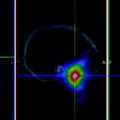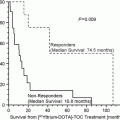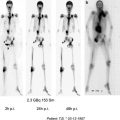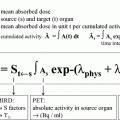Radionuclides
PET
SPECT
Therapy (beta)
Therapy (alpha)
Short half-life
Long half-life
Short half-life
Long half-life
Readily available—worldwide access—GMP grade
18F
124I
99mTc
111In
131I
90Y
–
Available—local access only
(64Cu)
(82Rb)
89Zr
123I
67Ga
186Re
(166Ho)
177Lu
–
Potentialy availability before 2015
(68Ga)
–
–
–
(188Re)
(223Ra)
Potential interest (long term)
–
–
–
–
(67Cu)
(211At)
(225Ac) (212Pb)
The radiopharmaceutical drugs that will come on the market within the next ten to fifteen years will be limited to the ones for which large-scale manufacturing units under GMP conditions are available today or will be within the next five years:
131I is the most developed radionuclide, still included in NCEs, but serious limitations in the future, mainly in Europe, may question further development of iodine-labeled radiopharmaceuticals in general. Advanced projects may however benefit from the easy access to 131I and for the next ten years some interesting new 131I labeled molecules will still reach the market
GMP grade 90Y is readily available and at present there is no special concern related with this radionuclide. Decision to label an NCE with 90Y will mainly depend on the clinical target indication, but not on the industrial availability
The highest priority will definitely be given to 177Lu. Several companies are now upgrading their manufacturing capacities in order to provide GMP grade 177Lu. Contamination with 177mLu may become a serious drawback in the near future and one will definitely have to come up with solutions. Sources of 177Lu produced from the indirect 176Yb route not generating the 177mLu impurity will have a preference
There is a future for 188Re although this radionuclide does not show an ideal safety profile. It will generate some specific waste issues when handled in very large amounts in the manufacturing plants. Nonetheless, its major advantage is to be the rare therapeutic radionuclide produced via a generator. Presently, no GMP grade generator is available. Development of a GMP generator will make sense if there is a guarantee that a 188Re-labeled drug has a chance to come on the market: both are definitely linked
166Ho is lacking of manufacturing units and has properties that are not very different from other available radionuclides. It can be replaced by some of the ones listed above. It will be difficult to convince manufacturers to invest in new GMP facilities for 166Ho if 177Lu becomes readily available. The situation is similar for 153Sm, 169Er and 186Re that are readily accessible. However, the level of purity and quality are surpassed by radionuclides with better profiles for labeling
As seen above, 67Cu has probably an ideal profile for therapy but as long as larger amounts of this radionuclide cannot be produced it has no industrial future
This list seems quite short, but one must understand that other radionuclides could still be of interest, provided the developers find industrial partners that are ready to invest in the manufacturing tools for a worldwide distribution. If the development of a new radiotherapeutic agent is linked to a new radionuclide, it must be anticipated that the overall development of this new molecule will need at least 5 years more time to solve the radionuclide manufacturing issues.
We have seen some initiatives to bring new radionuclides on the market, and surprisingly in the field of alpha-emitters. The Arronax project will serve as the pilot project for the development of Astatine 211, but due to the short half-life of this radionuclide, investment to cover the expected marketing area will result in a need for investment probably higher than € 150 M. The same will happen for 225Ac. Actinium 225 will face, on top of this, further safety limitations due to the production of uncontrolled secondary alpha particles. Very recently, high quality grade 212Pb was made available. This will probably be the second alpha-emitter of interest, next to 211At. However, as this radionuclide is new for the community, its advantages will have to be proven over the existing ones. In addition to that, further investments in terms of production will be mandatory. Finally, one has to mention 223Ra that will be produced under GMP conditions as it is part of the first alpha-emitter compound that will come on the market (Alpharadin-223-Radium chloride—from Algeta/Bayer Pharma).
The radionuclides with a future seen from the industry’s perspective are collected in Table 1. Just for the sake of comparison, imaging radionuclides have been added as well. This group has been divided into subgroups of short and long half-life radionuclides, property which is important in diagnosis where biological processes have to be taken into consideration (see Table 2). Half-life of radionuclides in therapeutics is of lower importance in terms of efficacy (also in the sense it is not a limiting factor), but definitely must be taken into consideration when accounting for the dosimetry to patient or to staff. The chemistry of the element, i.e., covalent binding versus chelating chemistry, has not been taken into account. With the exception of fluorine and iodine, it is hopeless to expect the development of new radionuclides that can be bound covalently. The future of therapeutics will definitely be based on chelating chemistry.
Table 2
Properties of radionuclides of industrial interest for therapy
Half-life (T½) | Properties | Expected availability (GMP grade) | Comments—Issues to solve | |
|---|---|---|---|---|
Beta-emitters | ||||
Copper 67 | 67Cu: 61.83 h | 392 keV (β; 57 %) Also γ emitter at 184 keV (49 %) | Difficult to predict | Cyclotron product—feasibility of large scale manufacturing not possible yet—GMP missing |
Holmium 166 | 166Ho: 26.83 h | 1,855 keV (β; 50 %), 1,774 keV (β; 49 %) | Local quality | Fission product—only isolated manufacturing sites existing—GMP missing |
Iodine 131 | 131I: 8.02 d | 606 keV (β; 90 %) Also γ emitter at 364 keV (81 %) | Available | Fission product—readily available—issues linked to waste and dosimetry |
Lutetium 177 | 177Lu: 6.73 d | 498 keV (β; 79 %) Also γ emitter at 208 keV (11 %) | Available (two qualities) | Contamination with177mLu (T½ = 160.4 d)—reactor product—large-scale GMP manufacturing sites under construction |
Rhenium 188 | 188Re: 17.00 h | 2,120 keV (β; 71 %) Also γ emitter at 155 keV (15 %) | 2014+ | Generator product (188W)—large scale GMP manufacturing missing |
Yttrium 90 | 90Y: 2.67 d | 2,284 keV (pure β) | Available | Generator product (90Sr)—readily available |
Alpha-emitters | ||||
Actinium 225 | 225Ac: 10.0d decays to221Fr, then217At,213Po and stable209Bi | 5,830 keV (α; 51 %)—no β (only first decay taken into consideration) | GMP not under development | Cyclotron product—emitting four alpha particles—major safety issue in case of contamination (acceptance by authorities to be demonstrated)—no GMP available |
Astatine 211 | 211At: 7.2 h
Stay updated, free articles. Join our Telegram channel
Full access? Get Clinical Tree
 Get Clinical Tree app for offline access
Get Clinical Tree app for offline access

|





